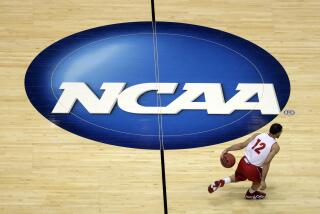Athletes Get Lower Grades, NCAA Study Finds : In Season, They Spend More Time on Their Sports Than They Do on Classes
- Share via
WASHINGTON — College athletes, especially basketball and football players, spend more time on their sports in season than they do on their classes and get lower grades than students involved in other time-consuming extracurricular activities, a year-long study by the National Collegiate Athletic Assn. showed.
The study, based on confidential questionnaires from 4,083 college athletes as well as students in other activities at 42 NCAA member institutions, was the first of its kind. It was conducted to gauge the academic effect that sports participation has on college athletes.
Although it documented a clear disparity in classroom performance, it offered “no surprises” about the problems student-athletes face, said Martin A. Massengale, chancellor of the University of Nebraska, who headed the NCAA committee that sponsored the $1.75-million study.
Robert J. Rossi, project director for the research firm that conducted the survey, said the heavy time demands on student-athletes make it “more difficult for them to make academics their top priority than it is for extracurricular students.”
The report is part of a larger NCAA analysis of intercollegiate athletics that is expected to be used as the basis for possible reforms. No major changes in sports policy are expected to be adopted next year, Massengale said, but the commission plans to consider such measures as reducing the maximum amount of practice time and making freshmen ineligible.
The report said that despite ample learning resources, such as special tutors, football and basketball players have an average grade-point average of 2.46 on a 4-point scale. The average for other college athletes was 2.61, and it was 2.79 for students involved in other time-consuming extracurricular activities, such as drama, band or student government.
The survey also found that about 12% of college basketball and football players report having experienced psychological and physical distress, mental and physical abuse, difficulty in avoiding drugs or alcohol and unsatisfactory academic performance. Only 4% of student-athletes in minor sports and 7% of those in other activities reported such problems.
According to the study, football and basketball players spend about 30 hours a week on their sports in season, even though most said they do not expect to play professionally. When the season is over, athletes spend about 18 hours a week in practice, but they do not spend much more time on academics, the survey found.
Whereas most of those athletes said that earning a college degree was “important” or “of greatest importance” when they started college, they spent about 14 hours a week in class and about 12 hours preparing for class during the sports season.
In contrast, students playing minor sports spent 25 hours a week in season on their sports and devoted a little more time to academics. Students involved in other time-consuming extracurricular activities spent about 20 hours a week on their activity, with 15 hours a week for classes and about 13 hours for preparation.
The findings provide “a baseline for the future, because we can trace their progress to see what steps can be taken for student-athletes,” said John W. Ryan, president emeritus of Indiana University and a consultant to the commission.
The commission plans to analyze the report, along with other parts of the study that it will release in early 1989, at a forum during the NCAA’s convention in San Francisco in January, Massengale said.
Other parts of the study will focus on black college athletes, female athletes, the academic performance of all student-athletes, and their college experiences.
More to Read
Go beyond the scoreboard
Get the latest on L.A.'s teams in the daily Sports Report newsletter.
You may occasionally receive promotional content from the Los Angeles Times.










